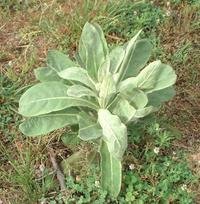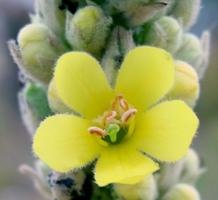





When we are very young and not yet wise in the ways of adults, we tend to see only what is in front of us. I knew at an early age the rights and wrongs, the goods and bads, and the coulds and could nots. Smoking was one of the wrongs, the bads, and the could nots. When I came upon Aunt Bett with smoke coming out of her mouth, I grabbed my asphidity bag and ran home.
It doesn't take us long during childhood to form an opinion about most adults in our lives. We assign them categories. There are those who are good and those who are bad, and we are to emulate the goods and avoid the bads. Aunt Bett was one of the goods, and I knew that everything she said and did was true and right. Then I learned that there are exceptions to most truths.
Great Mullein, Verbascum thapsus, is a plant that grows easily in soil that has been disturbed. Years ago in the mountains of southeast Kentucky, when a garden plot was made ready for spring planting, the edges of the garden were always plowed, but not always planted. That left a whole lot of disturbed soil all around the outer edges of a garden, and from this disturbed soil's seed banks, the great mullein grew. Families gardened on any flat area they owned, so it was not unusual for one family to have 2 or 3 garden plots, depending upon the amount of flat land available to them.
There was a dusty one lane road that ran along one side of Aunt Bett's garden and it was on that sunny side that the mullein grew. Aunt Bett valued the mullein as an important plant, and it was my job to collect all parts of it for drying. Now mullein is an unusual looking plant, it had hairy leaves that tapered from large to small up a tall stalk and merged into a mass of yellow flowers at the top. Not only was it unusual to look at, it also felt a little strange. The short white hairs covered both sides of the leaves and it felt much like the ear of a hound dog to me. The plant can grow to a height of 7 or 8 feet, much taller than I was, so most of the time I was told to simply collect the leaves. Aunt Bett had a use for the entire plant, and I knew it was important in the treatment of lung ailments, but I wasn't quite sure how that treatment worked. Nevertheless, I collected the leaves when the flowering was nearing completion, and laid them out on a screen to dry on the covered back porch, or more often I strung them on a piece of cotton twine to hang from the porch rafters as they dried. Sometimes I was told to roll the leaf into long skinny pencil-like shapes and string it on cotton twine . And so I did.
We all had electricity coming to us from very tall poles with long fat black wires running from the pole to the house. Some of the older folks, including Aunt Bett, didn't trust electricity and probably thought it was some young man's passing fancy, so she also had oil and kerosene lamps. She made the wicks for the lamps out of dried mullein leaves that had been dipped in bacon grease. Mullein was good for consumption and all manner of lung problems including asthma and pneumonia. I just wasn't sure how that mullein got into anybody's lungs, until the winter Aunt Bett caught a cold and it settled in her chest.
We had harvested sugar cane, boiled the sugar down, and made molasses one fall in the field between Granny Ninna's and Aunt Bett's houses. I remember the old horse going round and round, grinding the sugary juice out of the long canes while entire families stood on the outer edges of the circle watching. The fire from the syrup boil was in front of us and the fire from the tall dried mullein plants was glowing like giant candles behind us. The mullein was being used as torches to give the adults light to work by.
It was shortly after that night when Aunt Bett caught a cold. It settled in her chest. Now Aunt Bett was rarely sick, but when she was, my mother and Granny Ninna would often send me down the road carrying a sealed Mason fruit jar full of homemade chicken soup. It was winter, I remember, because the jar of soup was warm and I tucked it inside my coat. I got to Aunt Bett's house, went to the back door, (the front door was for company), opened it and stepped inside. I was family so I could do that. Most houses at the time had big bellied coal stoves in the living room to warm the house, and a wood burning cookstove with a pile of kindling right beside it for the kitchen, so it was not unusual to enter a smoky house expecially in the cold months. Aunt Bett's house was smoky.
I could see her sitting at the kitchen table with what I thought was a cigarette in one hand and a cup of coffee in the other. She was blowing smoke out of her mouth. I knew immediately that I had seen something I was not supposed to see, so I put the Mason fruit jar full of homemade chicken soup hard down on the table, held on to the asphidity bag that was in my pocket, and before saying "Good Morning, Aunt Bett," I turned and ran. I must have thought it would all disappear if I ran from it. I ran straight home, tears flying, nose dripping, right to the kitchen, and flung myself into Ninna's arms. "Ninnaaaaa, Aunt Bett was smokin' and that's a sin," I boohooed into her shoulder. I am not sure what Ninna said, but finally I calmed down enough to listen. "It was mullein that Aunt Bett was smokin', just to cure her cold," Ninna told me. "Remember that mullein you picked and rolled up to dry, well, that's what it's used for. Smoke it, and it cures colds." I decided then and there that there was no way anybody would ever get me to smoke mullein. I would just have to die from a chest cold. With the help of the homemade chicken soup and the dried mullein, Aunt Bett survived the chest cold, and I survived the lesson.
That isn't the end of the mullein story by far. It seemed there were so many lessons to be learned during my childhood, I began to think I would be stuck in childhood forever. But before you hear the rest of the mullein story, let me tell you a little about mullein as I knew it then.
Great mullein, also known as common mullein, was called Candlewick by my family. Some folks called it Beggar's Blanket. It grew everywhere, roadsides, gravel, sand, it didn't matter where it was, it would grow. We would usually harvest the entire plant when it was in full bloom because the sulfur yellow flowers could be used for dye. Aunt Bett used all of the plant for various ailments and in reading about it today I find that she knew exactly what she was doing. Scientific evidence agrees with Aunt Bett. It is an antihistamine, anti-inflammatory, anti-cancer, antioxidant, antiviral and a sedative. As an infusion it can be used for chest complaints. All parts of it are diuretic. Oils made from mullein are strong antibacterials. A decoction of the roots can be used to treat migraines. It can be used externally as well; a decoction of seeds sooths chapped skin and sunburn.
To make tea: boil dried leaves in water for 5 to 10 minutes.
To make mullein oil for soothing burns or other skin problems: crush and grind dried flowers, seed and root. Fill jar, cover with oil and place in a warm spot for a month. Strain and reserve the oil.
Now here is the good part. An infusion of the flowers can be used as hair dye to produce a golden tint. It was used historically to also restore color to gray hair, and the Roman ladies used an infusion of the flowers to add a golden glow to their hair. You, of course, already know what I did.
The white hair of my childhood was very absorbant. I spent one entire winter with mustard yellow streaks weaving their way through that white hair. I can tell you from experience that it also dyed hands, fingernails, and skin up to my elbows to a nice golden tan. We played jacks and pick up sticks on the desk tops in our classroom during recess that winter. My golden hands, mustard yellow hair, and tan nails got a lot of attention. My mother surely was a tolerant woman.
I should have tried that stuff on Aunt Bett's white hair first.
All photos are from Plant Files. Thank you Dave, htop, and Xenomorf for the use of your photos.
Research references for confirmation of medical usage:
www.botanical.com
www.springboard4health.com
www.altnature.com
Copyright © www.100flowers.win Botanic Garden All Rights Reserved